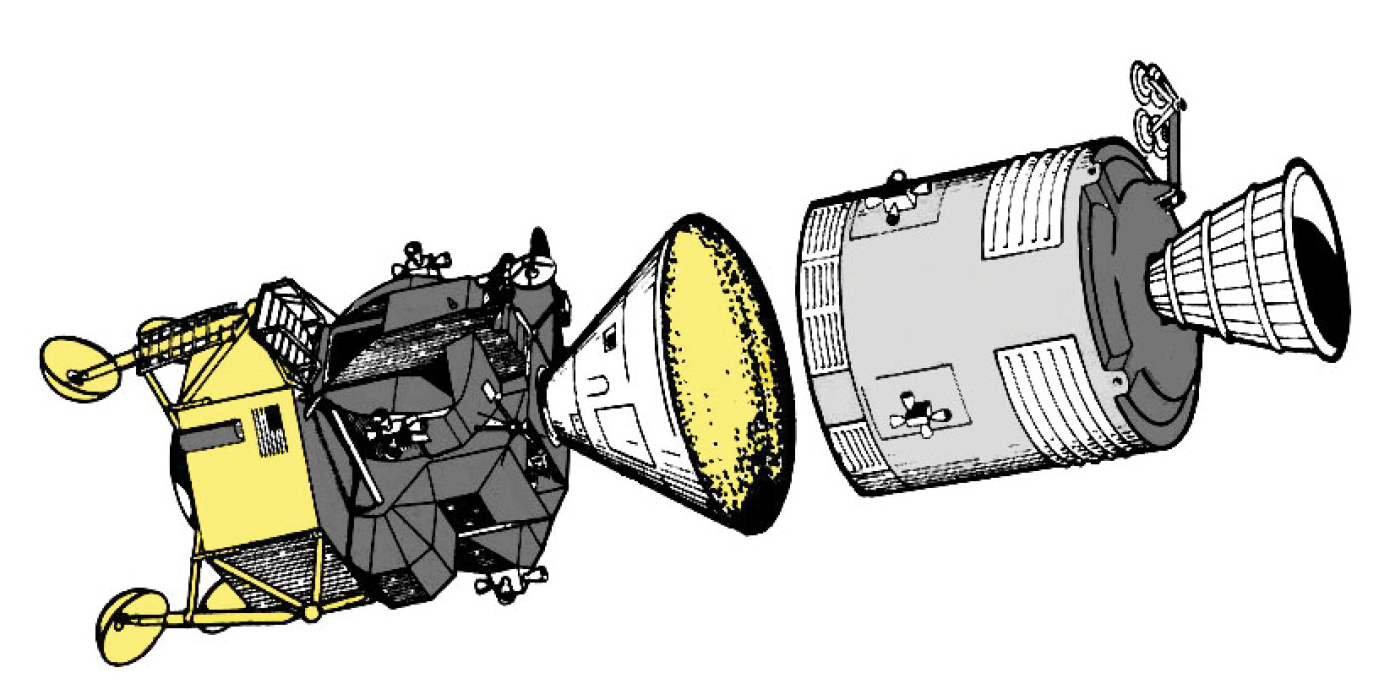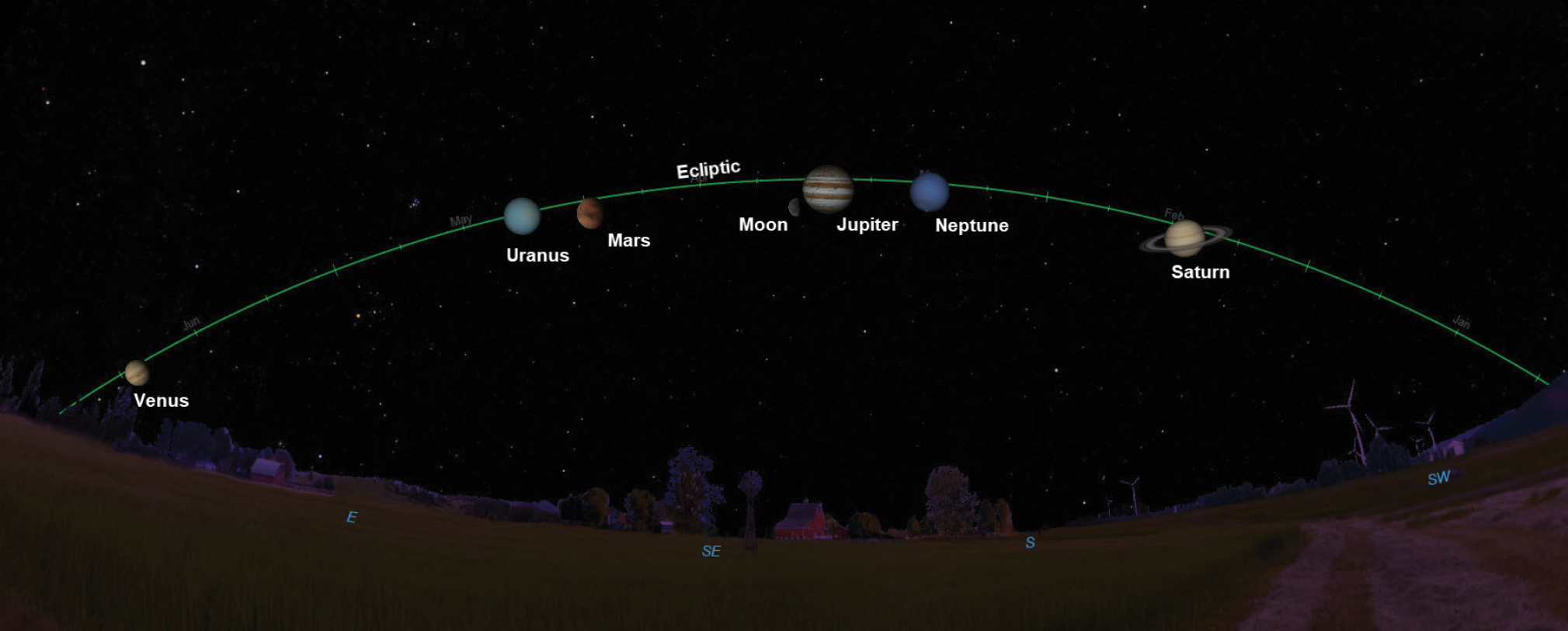Scope on the Skies
It’s All About the Moon
Science Scope—July/August 2022 (Volume 45, Issue 6)
By Bob Riddle
July 20, 1969, 3:17 p.m. EDT: “Houston, Tranquility Base here. The Eagle has landed,” Neil Armstrong radioed to Mission Control from their landing site near the lunar equator (0°41’ N: 23°26’ E) in the Sea of Tranquility. Thus started a 23.5-hour crewed mission on the surface of our Moon when Neil Armstrong stepped onto the lunar surface at 10:56 p.m. EDT. While not the first from our planet to touch the Moon, having been preceded by several robotic explorers, Neil Armstrong and Buzz Aldrin were the first humans from our planet to set foot on another world (see Figure 1). Video of this historic landing was recorded but the quality of the video and the positioning of the camera recording the landing offered a somewhat limited view. A computer-generated reconstruction with actual audio of the final several minutes of the landing was created by NASA’s LROC (Lunar Reconnaissance Orbiter Camera) team (see Online Resources).

Lunar mission landing sites.
During the 23.5 hours the two spent on the lunar surface, Michael Collins, the Command Module pilot, possibly had a lonelier job than the Maytag Repairman, as he orbited the Moon by himself waiting for Armstrong and Aldrin to return.
The Apollo 11 mission, and subsequent missions (Apollo 12–17) to our Moon, started on May 25, 1961 when then-President John F. Kennedy said these memorable words in a speech to the U.S. Congress: “I believe that this nation should commit itself to achieving the goal, before this decade [1960s] is out, of landing a man on the Moon and returning him safely to the Earth” (see Online Resources). So before that decade was over, a crew of three men departed Cape Kennedy Florida at 9:32 a.m. EDT on July 16, 1969, from Launch Pad 39A. Within the next several hours the Command and the Service Modules separated from the upper stage. Within the Service Module was the Lunar Module (LM), the Eagle. Following a short six-minute “burn,” the crew was in a translunar orbit on their way to the Moon.
As the crew traveled toward lunar orbital insertion, scheduled for July 19, they performed a variety of scheduled tasks including putting on their space suits and entering the LM to check out its systems. Two orbital burns later and about 100 hours into the Apollo 11 mission, on July 20, 1969, Armstrong and Aldrin entered the LM and started their descent to the Sea of Tranquility and the lunar surface. Less than three hours later, the Eagle had landed, and history was made.
The Apollo 11 mission was one of several missions that began a series of six successful manned missions to the lunar surface. Leading up to the Apollo 11 launch were several unmanned launches, Apollo 4, 5, and 6. These were followed by manned launches of Apollo 7, 8, and 9, testing as many of the lunar orbit and landing phases of the mission as could be duplicated in low Earth orbit. Apollo 10 was a dress rehearsal, as were the previous missions; however, this was a manned mission to the Moon and back doing everything except landing on the Moon. We all know what came next—Apollo 11, and 12 were successful missions, as were Apollo 15, 16, and 17.
Apollo 13
April 11, 1970, the Apollo 13 crew launched from Cape Kennedy in what was to be the third landing on the Moon when, on the second day into the mission, an oxygen tank exploded (see Figure 2). Then came this famous often-quoted line from Command Module Pilot Jack Swiggart: “Okay, Houston, we’ve had a problem here” (see Online Resources). The exploding oxygen tank damaged the power supply, leaving the crew with less than an hour of power in the Command Module and, most significantly, vented all the oxygen from the two oxygen tanks needed for the three-man crew. The Service Module essentially became unusable, so the mission became one of getting the crew back to Earth safely—leaving them no choice but to move into the LM. Because they were two days into their translunar orbit, they had to orbit the Moon and then return to Earth, which they safely did with a landing in the South Pacific on April 17 (see Figure 3).

View of the damaged Apollo 13 service module.

Diagram of Apollo 13 vehicles—the Lunar Module (LM) connected to Command Module and the Service Module.
The return trip was uncomfortable and physically challenging as the three crew members had to stay in the LM that would have been used for landing on the lunar surface until they moved back into the Command Module for the splashdown in the Pacific Ocean. Keep in mind that the LM was only meant for two days and for two astronauts that were to land on the Moon. Mission Control and the crew had to come up with a workable plan for the three to fit in the LM for the duration of the mission. They had to devise a way to remove exhaled carbon dioxide from three astronauts, not two, from the LM. There was a critical issue with having enough water for drinking and cooling equipment, such that each crew member was rationed to less than one cup (about 7 oz. of drinking water) for each of the four days it would take to return to Earth. The crew reduced equipment power consumption as low as possible, which left them in the dark and cold, 38°F (3°C). Water was condensing on the interior of the LM, adding dampness to the conditions. Imagine all of this while also being told not to jettison (flush) their urine out of the capsule for concerns that doing so would change their course trajectory. This meant storing their urine as well as solid waste in plastic bags. If you were wondering, there was no toilet.
As they approached Earth, another concern was when they shold separate from the Service Module as well as what the condition of the Command Module would be after being powered down. There was also concern over how the heat shield on the Command Module would withstand the cold of space if the Command Module were to be separated from the Service Module too soon. A few hours before entering the Earth’s atmosphere, the crew entered the Command Module and separated from the Service Module. On entering the Command Module, the crew found water droplets had condensed on its walls but fortunately there was no damage to any of the electrical systems. However, according to Mission Commander James Lovell, as the capsule entered the atmosphere, “The droplets furnished one sensation as we decelerated in the atmosphere: it rained inside the CM” (see Online Resources).
Got JUICE?
No, not the breakfast drink Tang (not an endorsement), but JUICE as in JUpiter ICy moons Explorer. This launch starts a seven- to eight-year voyage to Jupiter and a mission to explore three of Jupiter’s largest moons—Ganymede, Calisto, and Europa—with a series of flybys before entering orbit around the moon Ganymede. The launch widow runs from August 26 to September 15 with arrival at the Jovian system in 2030. If launch is not possible this year, the next launch window will not open until 2023.
Summer planets
This summer the visible planets, except for the innermost planet Mercury, will all be visible lined up in the morning skies before sunrise local time. To be clear, a planetary lineup is not planets arranged in a straight line outward from the Earth and Sun, but rather this lineup has the planets arranged from east to west along or near the ecliptic arranged from horizon to horizon. When the planets are arranged like this, it is easier to picture the ecliptic, the Earth’s orbit, a reference line used for planet location (see Figure 4).

Summer planetary lineup—July 19, 5:00 a.m. local time.
During the summer months, sunrise is rather early, but early rising could be rewarded by viewing the arrangement of the visible planets across the horizon. Watch for the Moon twice—once during July and again during August—in its waning phases, to follow the ecliptic passing by each of the planets in a series of conjunctions. Starting with the morning of July 15, the waning gibbous Moon will be near the planet Saturn, and by July 26, the very thin waning crescent Moon will be rising near the planet Venus. Then during August, the full Moon will be repeating the same series of conjunctions but this time starting on August 11 in a close conjunction with Saturn and ending with rising with Venus on the mornings of August 25 and 26.
Did you notice that there was basically the same series of conjunctions between the Moon and planets yet each one started and ended on a different date, and occurred with a different Moon phase? So what is going on? It’s all about motion—the Earth is moving, the planets are moving, our Moon is moving, the Sun is moving, the stars are moving. And it appears as if the sky is moving. The obvious and most noticeable motion is the apparent motion of celestial objects toward the west as the Earth rotates toward the east. Pay attention to the positions of the planets, at least Mars and Venus this summer, and you may notice that they are moving toward the east as they revolve around the Sun. Venus will be the most obvious of the two in that motion. The Moon moves eastward much more quickly than any of the planets, so it catches up with and passes each planet. Because the Earth is also moving along its orbit, the angle or perspective from which we view the planets and our Moon is constantly changing, as you can see from observing the Moon and planets.
For students
- Click on the name of lunar mission at the online interactive map of our Moon to learn more or to learn about other missions to the surface of our Moon.
- Establish your space piloting “creds” with the online Lunar Lander Simulator, or with the ISS Docking Simulator.
- The recorded conversations between mission control and the Apollo crew members is interesting reading and perhaps could be turned into a classroom performance of some sort.
- How fast or, more appropriately, how much do the planets and our Moon really move eastward each day? Look up the revolution period of each planet and convert that to Earth days. Divide 360o by the number of Earth days and that is how much each planet and our Moon move each day. •
Online Resources
July/August Sky Calendar—https://bit.ly/3bVHGXy
Visible Planets—https://bit.ly/3nLzxrs
Apollo Lunar Simulator—https://bit.ly/39n8tuR
Apollo 11 Landing Simulation Video—https://bit.ly/3mIXKOy
Apollo 11 Mission Overview—https://go.nasa.gov/39xPHkq
Apollo 13 Flight Journal—https://go.nasa.gov/3mNbB6k
Apollo 13 Flight Journal, day 3—https://go.nasa.gov/3xvphrt
Apollo 13 Mission pages—https://go.nasa.gov/3tAzAtv
Apollo Missions—https://go.nasa.gov/3HrfJ5t
Interactive Map of Lunar Landings—https://bit.ly/3xQmRp1
JUICE: JUpiter ICy moons Explorer—https://go.nasa.gov/3tzeNWU
Kennedy’s Speech (excerpts) to Congress—https://go.nasa.gov/3xwonei
Mars Pathfinder Mission—https://go.nasa.gov/3xrayOo
National Aviation Day—nationalaviationday.org/
Space-X ISS Docking simulator—iss-sim.spacex.com/
What Armstrong Saw: Simulation—https://bit.ly/3MRo3wr
Bob Riddle (bob-riddle@currentsky.com) is a science educator in Lee’s Summit, Missouri. Visit his astronomy website at https://currentsky.com.
Aerospace Astronomy Middle School


